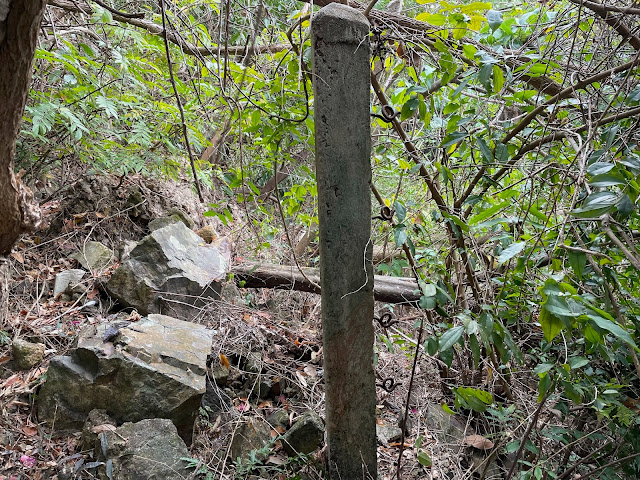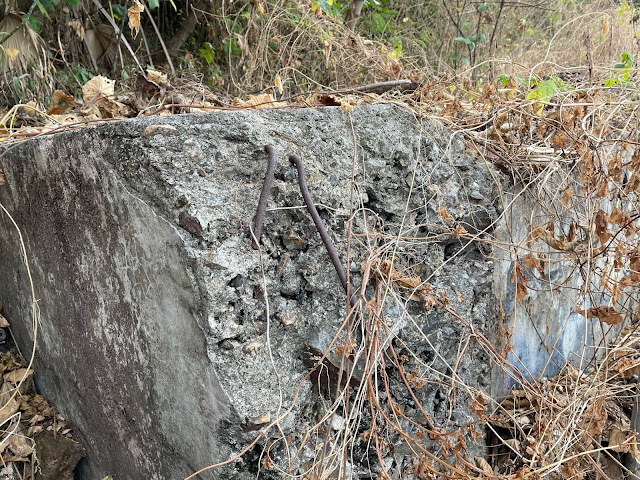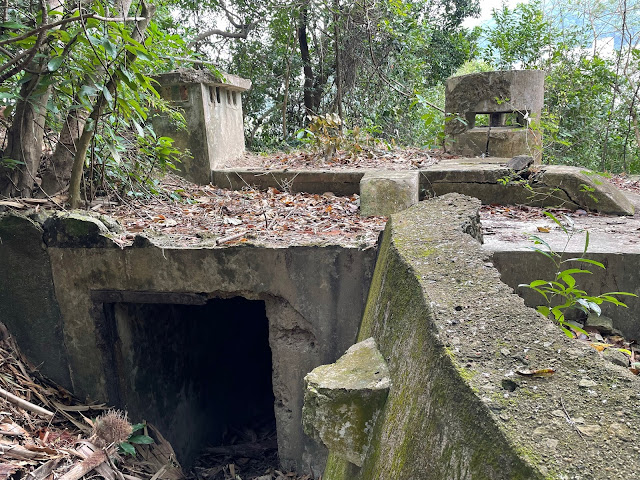I am in search for any traces of PB 19 at the northern end of Middle Bay. I go down some old steps beside No. 20 South Bay Road leading to a rocky beach some 30 metres north of the shark nets at Middle Bay. On the way down I go past a number of WW2 type concrete stanchions for anchoring down the barbed wire. PBs normally had a barbed wire perimeter around them and this indicated that I was on the right track.
Short articles focused on WW2 in Hong Kong and Singapore in particular and military history in general. Click the "Follow" button to receive new posts. For general enquiries please contact: Philip.G.Cracknell@gmail.com
Monday, 24 January 2022
PB 19 at Middle Bay
Sunday, 23 January 2022
Beach Defence Unit (PB 24 and LL 24)
Saturday, 22 January 2022
Pte Donald MacDonald - 'A' Coy 2nd Battalion Royal Scots - Battle for Hong Kong
Donald Walker MacDonald was born 6 July 1922 in Glasgow. He joined the Army as a boy soldier aged fifteen. In 1938, at the age of sixteen, he was sent out to Hong Kong where he served with the 2nd Battalion Royal Scots. The battalion had arrived in Hong Kong in January 1938 from India. I do not have a record of which company (Coy) he served in, but in 1975, he recalled in a press interview that he was based at the Shing Mun Redoubt. So we can assume he was with 'A' Coy commanded by Captain Cyril Jones.
'A' Coy consisted of three platoons, one of which was located in the redoubt, and the other two platoons were close to the redoubt. The Coy HQ was situated in an Artillery Observation Post (AOP) at the back of the redoubt.
Tuesday, 18 January 2022
Line of Gap Pillbox No. 16 (LPB 16)
Also known as Kennedy Town Gap PB. A three-loophole PB situated on the hillside above Pofulam Road near Queen Mary Hospital. It has been occupied as a dwelling. The building is well cared for and the area around the PB has been gardened. The steel loophole shutters look in very good condition. I could not see the commanders observation tower and ventilation shaft (presumably demolished). I was unable to go inside or stay too long as I felt I was intruding on somebody's home.
Line of Gap Pillbox No. 18 (LPB 18)
LPB 18 is also referred to as Kennedy Town Gap PB 1. It was one of three line of gap pillboxes (LPB 16, 17, 18) situated in and around the gap between Mount Davis and High West. Pok Fu Lam Road runs through the gap. The PB is situated on the north eastern slopes of Mount Davis at the rear of the Chiu Yuen Cemetery. PB 17 has been demolished. PB 16 is used as a dwelling house.
Condition: The stone/pebble cladding remains over parts of the outside of the PB. The rock rampart is partly intact. It has a large gun chamber accommodating four loopholes. The Japanese extended the MG mountings. There is what may be a Japanese tunnel. The Japanese must have put this PBB to use. the loophole shutters look in good condition. The commanders observation tower is cracked on the outside. There are also cracks in the concrete roof and air-ducts.
.................
Pillbox 16
This was a Beach Defence Unit consisting of PB and Lyon Light situated on the shoreline between Repulse Bay and Deep Water Bay, opposite Middle Island. Only the Lyon Light structure on a concrete tower has survived. The steel shutters still remain in the searchlight aperture. The entrance can be seen at the bottom of the tower structure in the photo below. There is an upper steel door into the searchlight , engine and accommodation compartment. The two-man crew of the Lyon Light were in contact with the PB by voice pipe.

PB Commander was Sgt George Tattam, 1/Mx 'C' Coy
'C' Coy were responsible for Beach Defence PBs from PB 12 (Brick Hill) to PB 20 (South Bay). C Coy Commander was Major Henry Marsh. Coy HQ was located at war shelters on Shouson Hill.
Originally 2/Lt Cheeeswright was in command of PBs 15, 16 and 17. He spent a night in each PB in turn and when the Japanese reached Repulse Bay (20 Dec) he was in PB 17. After 2/Lt Grounds was killed at RBH - Cheesewright commanded PB 16, 17, 18, 19, and 20. PBs 12, 13 and 15 were evacuated on 19 Dec (MX war Diary) (Leaving PB 14 isolated and PBs 16 to 20).
On 23 Dec According to 2/Lt Cheeswright: PB 17, 18, 19 and 20 were evacuated to Stanley. (What about PB 16?) It may have been evacuated earlier to avoid being cut off. Major Marsh writes that "16, 17, 18, 19, and 20 were successfully withdrawn to Stanley" (Mx War Diary) but PB 16 is not mentioned in the description of the withdrawal to Stanley by 2/Lt Cheesewright. Tattam (PB 16 Commander) was involved in the fighting at Stanley....... but what is not clear is whether his crew were evacuated on 23 Dec with 17,18,19 & 20 or separately on or or before this date.
PB 16 is believed to be 3-loophole PB (?) probably built between 1939 and 1941.
...................
Friday, 14 January 2022
Anti-Aircraft Searchlights (AASL)
The Royal Engineers War Diary (UKNA File: CAB 106/37) states that 22 Fortress Coy Royal Engineers was formed in 1937/38 to man the twenty-four anticipated AA Searchlight (AASL) stations located in Kowloon, the New Territories and on HK Island. Later following a revised defence plan that envisaged an evacuation of the Mainland and a defence of HK Island (the Island) the number was reduced. There would be thirteen AASLs located on Hong Kong Island and some of the nearby islands including Aberdeen Island, Green Island and Stonecutters Island. The thirteen AASLs included the following:
The war diary states that the AASL detachments did not perform in the role anticipated. This was largely because there were no night raids. The Japanese Air Force restricted their combat missions to daylight hours. Three or four detachments were used to man the Defence Electric Lights (DELs) these were search lights used by the coastal defence batteries. The AASLs were manned at the outset of the battle but some were redeployed to DEL or other duties as it became clear that the Japanese were not carrying out night operations.
A report issued by Lt-Col Lamb, RE, (UKNA File: WO 172/11400) stated that the AASL and DEL on Sonecutters Island was evacuated on 12 December 1941 confirming that the RE had already taken over the manning of some DELs and were manning the AASLs. Lt-Col Lamb makes reference to the Collinson AASL being hit by shellfire on 13 December and the Sai Wan AASL station being attacked by Fifth Columnists. On 14 December he writes that the Green Island AASL was evacuated. Lamb describes how on 15 December the Braemar AASL was relocated and redeployed to perform a DEL role at North Point i.e. the searchlight was to be used for the harbour rather than aerial usage. Lamb also mentions a second attack by Fifth Columnists on the Sai Wan AASL. On the same day the Aberdeen AASL (on Aberdeen Island) was damaged by aerial bombing. The RE also operated a searchlight referred to as a 'sentry beam' located near Pak Sha Wan Battery. After the Japanese landings there is no further reference to the AASL stations - presumably at that point there crews were all redeployed. Within a few days of the Japanese landings there were only three or four AASLs that could be utilised and still no night raids so they had become redundant.
The AASL sites were usually fixed positions with reinforced concrete structures for the engine house and the store house. The engine house contained the diesel powered generator. The store house was used for storing the equipment and for the crew accommodation. The AASL crew consisted of ten to twelve men. There may have been a flat platform or shallow depression for the searchlight. A sound locator would have been located close to the searchlight. The lights were 90 cm and 120cm in diameter. The AA searchlight could be manhandled on its caterpillar tracks.
Gallery:




























